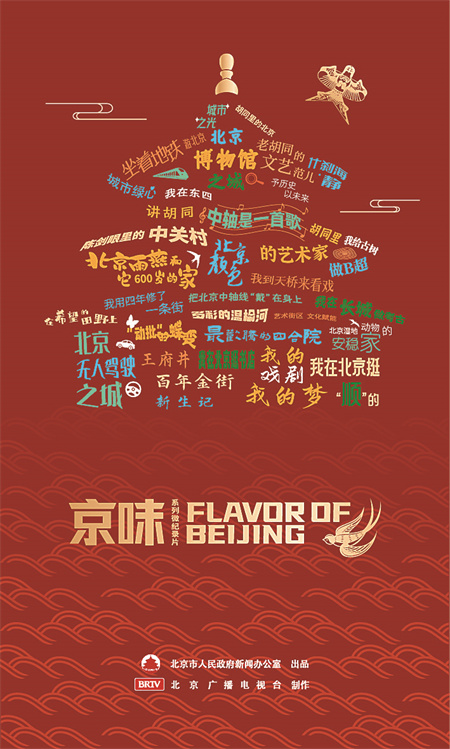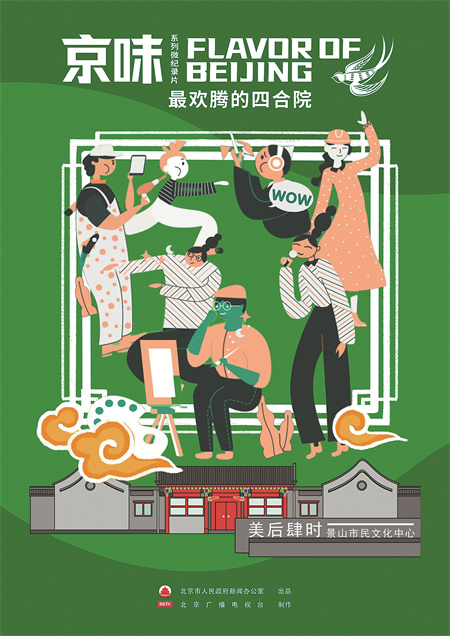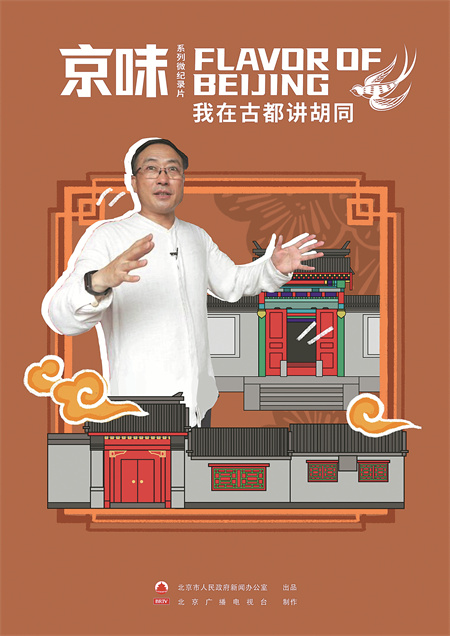A different view of the capital
China Daily2022-10-12 08:38

A poster publicizing the "Beijing swift" episode of the documentary miniseries, Flavor of Beijing.[Photo provided to China Daily]
City's progress and traditions given unique treatment with an innovative style in documentary, Li Yingxue reports.
"My name is Bro Qiang, and I'm a Beijing swift. I was born at the Zhengyangmen Gate on the Beijing Central Axis," says the bird with human characteristics, not least language. It is fair to say that this is a unique view of Beijing. In actual fact it is a scene from the third episode of documentary miniseries Flavor of Beijing, which was released on Sept 23. It tells the capital's story through multiple perspectives to the world.
With a height of 43.65 meters, Zhengyangmen Gate is one of the most magnificent entrances on the Central Axis of Beijing, and Beijing swifts have been living there for over 600 years.

Posters advertising various episodes of the miniseries. The documentary reveals some fascinating highlights of the capital.[Photo provided to China Daily]
"We migrate every year. We leave the Zhengyangmen Gate in July and return in April," says the swift in the documentary.
According to Guan Zhanxiu, director of Beijing Central Axis heritage protection center, the swifts' migratory route is particularly long. "They fly out of our country through the Xinjiang Uygur autonomous region, then through several Central Asian countries and along the Red Sea before finally ending up in South Africa. It is almost similar to our ancient Silk Road," Guan says.
In 2018, Guan's team set up 12 cameras around an actual swift's nest to observe and protect the birds within, and even witnessed a couple of swift families breeding.
Produced by the information office of the Beijing municipal government and Beijing Radio and Television Station, the bilingual 30-episode series takes the audience on a journey exploring Beijing, presenting the capital city in a down-to-earth and authentic way, showing the richness and development of the city.

Posters advertising various episodes of the miniseries. The documentary reveals some fascinating highlights of the capital.[Photo provided to China Daily]
Each episode, lasting four to five minutes, selects a theme and presents a vivid story of ordinary people. The show highlights a couple of keywords including "inheritance", "street", "growth", "renewal" and "living creature".
The protagonists of the documentary are from various fields, ranging from city planners and young people who work in high-tech companies, to doctors who treat ancient trees and readers who love to visit bookstores, as well as foreigners who relish Beijing and Chinese culture.
Lu Qiuping, head of operations at Meihousishi Jingshan Civic Cultural Center in Beijing's Dongcheng district, tells the story of how they run the center, which is located in a quadrangle courtyard and is a fashionable public cultural space that attracts young people.
Opened in September 2020, the center functions 365 days a year with around 1,000 free events, including drama performances and amateur theater workshops.
Posters advertising various episodes of the miniseries. The documentary reveals some fascinating highlights of the capital.

Posters advertising various episodes of the miniseries. The documentary reveals some fascinating highlights of the capital.[Photo provided to China Daily]
"Beijing is an attractive city with cultural richness," Lu says. "It's our slogan to see Beijing in our small courtyard. We hope to spread Chinese and Beijing culture based on our events and activities and turn our courtyard into a showcase of China's cultural confidence."
The documentary focuses on multiple topics pertinent to Beijing, including cultural heritage, ecological development, preservation of the old town and the construction of the international consumption center.
Bian Jian, deputy editor-in-chief of Beijing Radio and Television Station, says the production team held several planning meetings to finally choose the innovative micro-documentary filming method, as it's an innovative expression of the traditional documentary, which is recorded in a new media context using short videos.
"The 30-episode show visits all corners of Beijing, objectively showing the lives of people, the development of Beijing as a city and the spirit of the time in China, all from a micro perspective," Bian says.
"The documentary not only satisfies the rapid communication needs of modern society with its fragment-like format, but is a microscopic, historical image of Beijing in the new era," he says.
According to Xu Hejian, spokesman of Beijing municipal government, the documentary — showing Beijing's great achievements around the theme of "what kind of capital is being built and how to build the capital" — took two years to make.
"As the wheel of history is steadily moving forward, what has changed is the appearance of the city, while what remains unchanged is the unique heritage and essence of Beijing," Xu says.
Xu says that he hopes the audience will experience the coexistence of ancient and modern Beijing through the documentary, which will enable more people from different countries to better understand the city.
